Audit Assurance and Compliance
VerifiedAdded on 2023/04/19
|17
|4512
|195
AI Summary
This report explores the concept of auditor's materiality and its impact on stakeholder decision making. It also discusses the risks posed by material misstatement and the lessons auditors can learn from the Enron scandal. Case study: Woolworths.
Contribute Materials
Your contribution can guide someone’s learning journey. Share your
documents today.
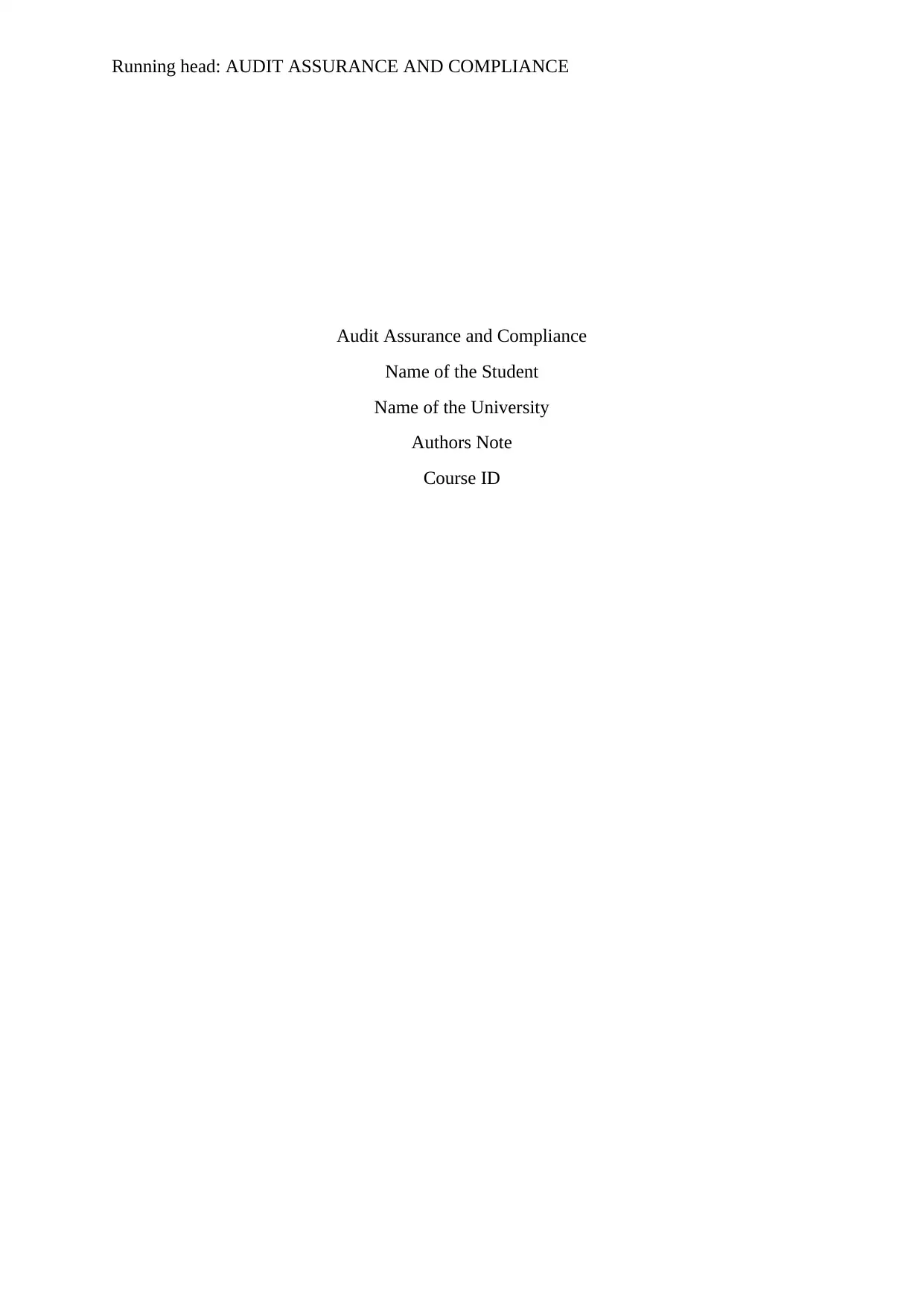
Running head: AUDIT ASSURANCE AND COMPLIANCE
Audit Assurance and Compliance
Name of the Student
Name of the University
Authors Note
Course ID
Audit Assurance and Compliance
Name of the Student
Name of the University
Authors Note
Course ID
Secure Best Marks with AI Grader
Need help grading? Try our AI Grader for instant feedback on your assignments.
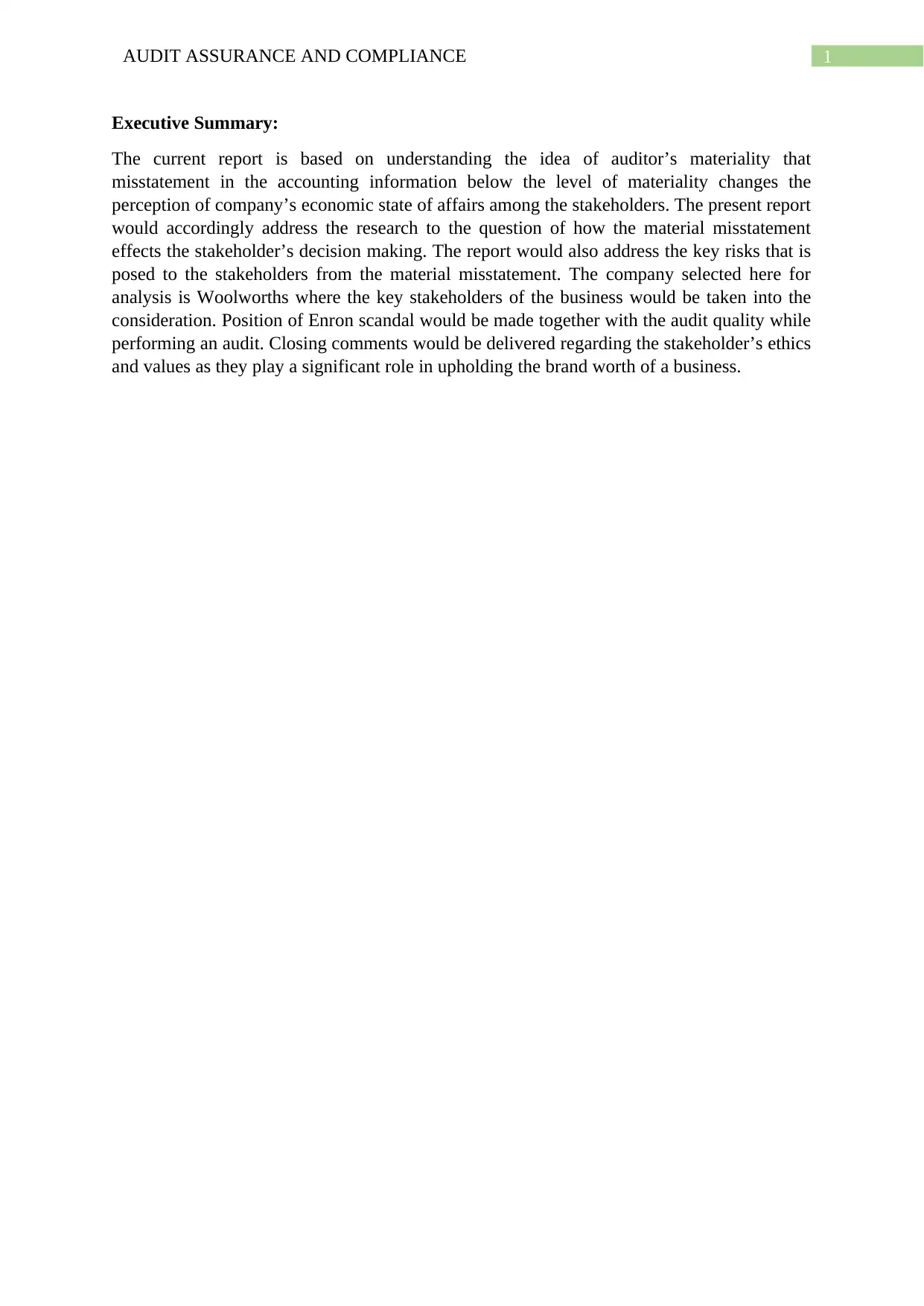
1AUDIT ASSURANCE AND COMPLIANCE
Executive Summary:
The current report is based on understanding the idea of auditor’s materiality that
misstatement in the accounting information below the level of materiality changes the
perception of company’s economic state of affairs among the stakeholders. The present report
would accordingly address the research to the question of how the material misstatement
effects the stakeholder’s decision making. The report would also address the key risks that is
posed to the stakeholders from the material misstatement. The company selected here for
analysis is Woolworths where the key stakeholders of the business would be taken into the
consideration. Position of Enron scandal would be made together with the audit quality while
performing an audit. Closing comments would be delivered regarding the stakeholder’s ethics
and values as they play a significant role in upholding the brand worth of a business.
Executive Summary:
The current report is based on understanding the idea of auditor’s materiality that
misstatement in the accounting information below the level of materiality changes the
perception of company’s economic state of affairs among the stakeholders. The present report
would accordingly address the research to the question of how the material misstatement
effects the stakeholder’s decision making. The report would also address the key risks that is
posed to the stakeholders from the material misstatement. The company selected here for
analysis is Woolworths where the key stakeholders of the business would be taken into the
consideration. Position of Enron scandal would be made together with the audit quality while
performing an audit. Closing comments would be delivered regarding the stakeholder’s ethics
and values as they play a significant role in upholding the brand worth of a business.
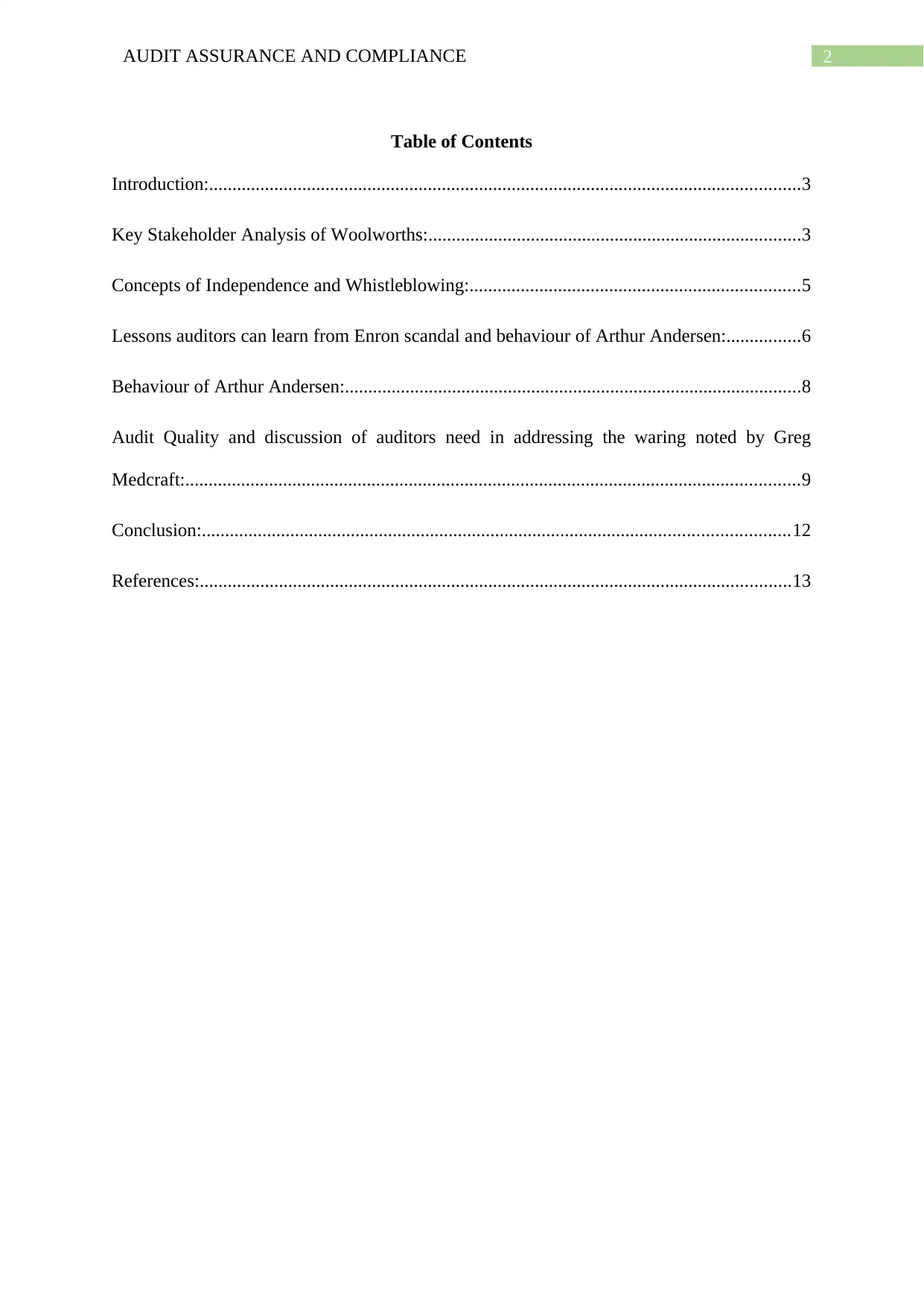
2AUDIT ASSURANCE AND COMPLIANCE
Table of Contents
Introduction:...............................................................................................................................3
Key Stakeholder Analysis of Woolworths:................................................................................3
Concepts of Independence and Whistleblowing:.......................................................................5
Lessons auditors can learn from Enron scandal and behaviour of Arthur Andersen:................6
Behaviour of Arthur Andersen:..................................................................................................8
Audit Quality and discussion of auditors need in addressing the waring noted by Greg
Medcraft:....................................................................................................................................9
Conclusion:..............................................................................................................................12
References:...............................................................................................................................13
Table of Contents
Introduction:...............................................................................................................................3
Key Stakeholder Analysis of Woolworths:................................................................................3
Concepts of Independence and Whistleblowing:.......................................................................5
Lessons auditors can learn from Enron scandal and behaviour of Arthur Andersen:................6
Behaviour of Arthur Andersen:..................................................................................................8
Audit Quality and discussion of auditors need in addressing the waring noted by Greg
Medcraft:....................................................................................................................................9
Conclusion:..............................................................................................................................12
References:...............................................................................................................................13
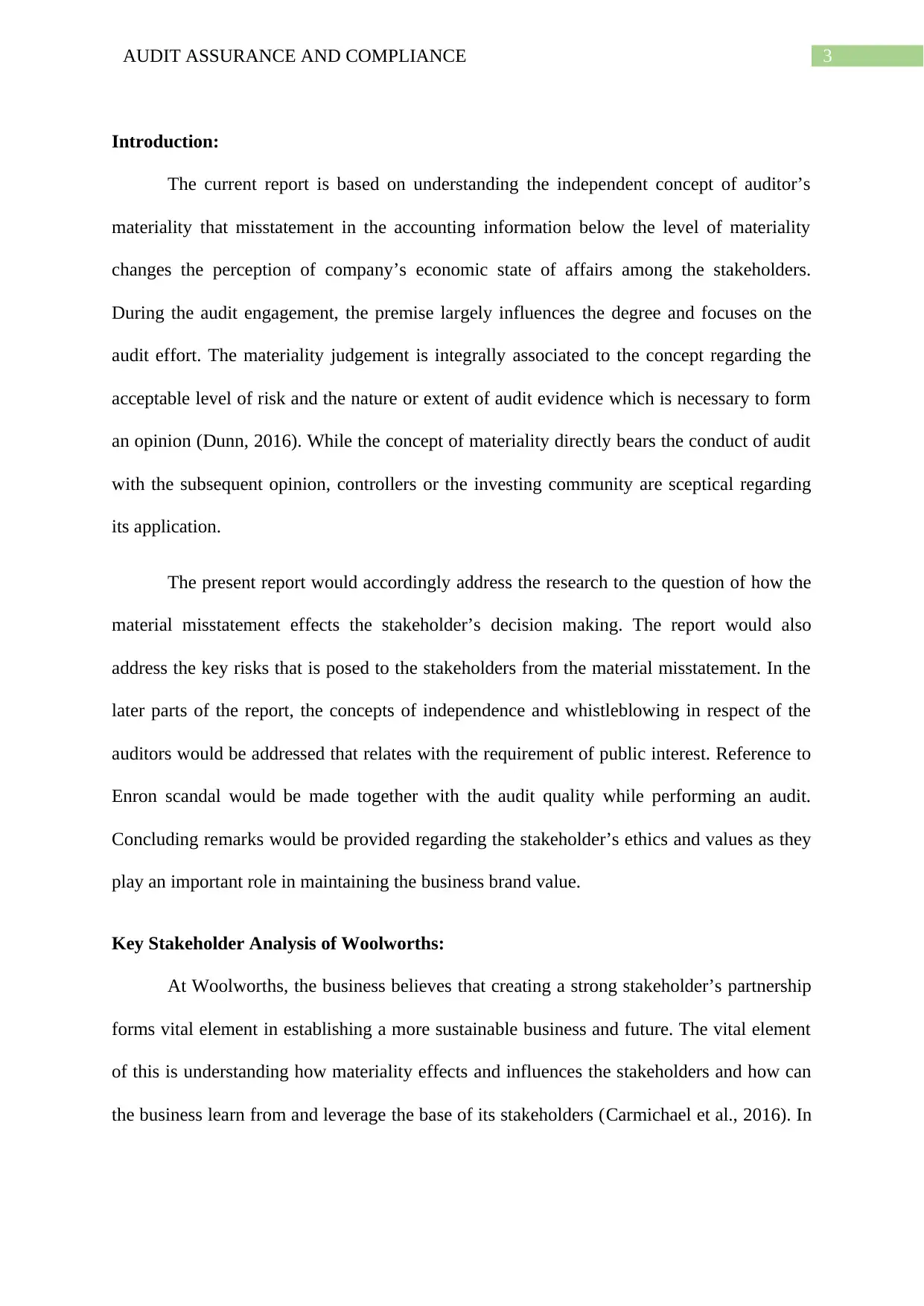
3AUDIT ASSURANCE AND COMPLIANCE
Introduction:
The current report is based on understanding the independent concept of auditor’s
materiality that misstatement in the accounting information below the level of materiality
changes the perception of company’s economic state of affairs among the stakeholders.
During the audit engagement, the premise largely influences the degree and focuses on the
audit effort. The materiality judgement is integrally associated to the concept regarding the
acceptable level of risk and the nature or extent of audit evidence which is necessary to form
an opinion (Dunn, 2016). While the concept of materiality directly bears the conduct of audit
with the subsequent opinion, controllers or the investing community are sceptical regarding
its application.
The present report would accordingly address the research to the question of how the
material misstatement effects the stakeholder’s decision making. The report would also
address the key risks that is posed to the stakeholders from the material misstatement. In the
later parts of the report, the concepts of independence and whistleblowing in respect of the
auditors would be addressed that relates with the requirement of public interest. Reference to
Enron scandal would be made together with the audit quality while performing an audit.
Concluding remarks would be provided regarding the stakeholder’s ethics and values as they
play an important role in maintaining the business brand value.
Key Stakeholder Analysis of Woolworths:
At Woolworths, the business believes that creating a strong stakeholder’s partnership
forms vital element in establishing a more sustainable business and future. The vital element
of this is understanding how materiality effects and influences the stakeholders and how can
the business learn from and leverage the base of its stakeholders (Carmichael et al., 2016). In
Introduction:
The current report is based on understanding the independent concept of auditor’s
materiality that misstatement in the accounting information below the level of materiality
changes the perception of company’s economic state of affairs among the stakeholders.
During the audit engagement, the premise largely influences the degree and focuses on the
audit effort. The materiality judgement is integrally associated to the concept regarding the
acceptable level of risk and the nature or extent of audit evidence which is necessary to form
an opinion (Dunn, 2016). While the concept of materiality directly bears the conduct of audit
with the subsequent opinion, controllers or the investing community are sceptical regarding
its application.
The present report would accordingly address the research to the question of how the
material misstatement effects the stakeholder’s decision making. The report would also
address the key risks that is posed to the stakeholders from the material misstatement. In the
later parts of the report, the concepts of independence and whistleblowing in respect of the
auditors would be addressed that relates with the requirement of public interest. Reference to
Enron scandal would be made together with the audit quality while performing an audit.
Concluding remarks would be provided regarding the stakeholder’s ethics and values as they
play an important role in maintaining the business brand value.
Key Stakeholder Analysis of Woolworths:
At Woolworths, the business believes that creating a strong stakeholder’s partnership
forms vital element in establishing a more sustainable business and future. The vital element
of this is understanding how materiality effects and influences the stakeholders and how can
the business learn from and leverage the base of its stakeholders (Carmichael et al., 2016). In
Secure Best Marks with AI Grader
Need help grading? Try our AI Grader for instant feedback on your assignments.
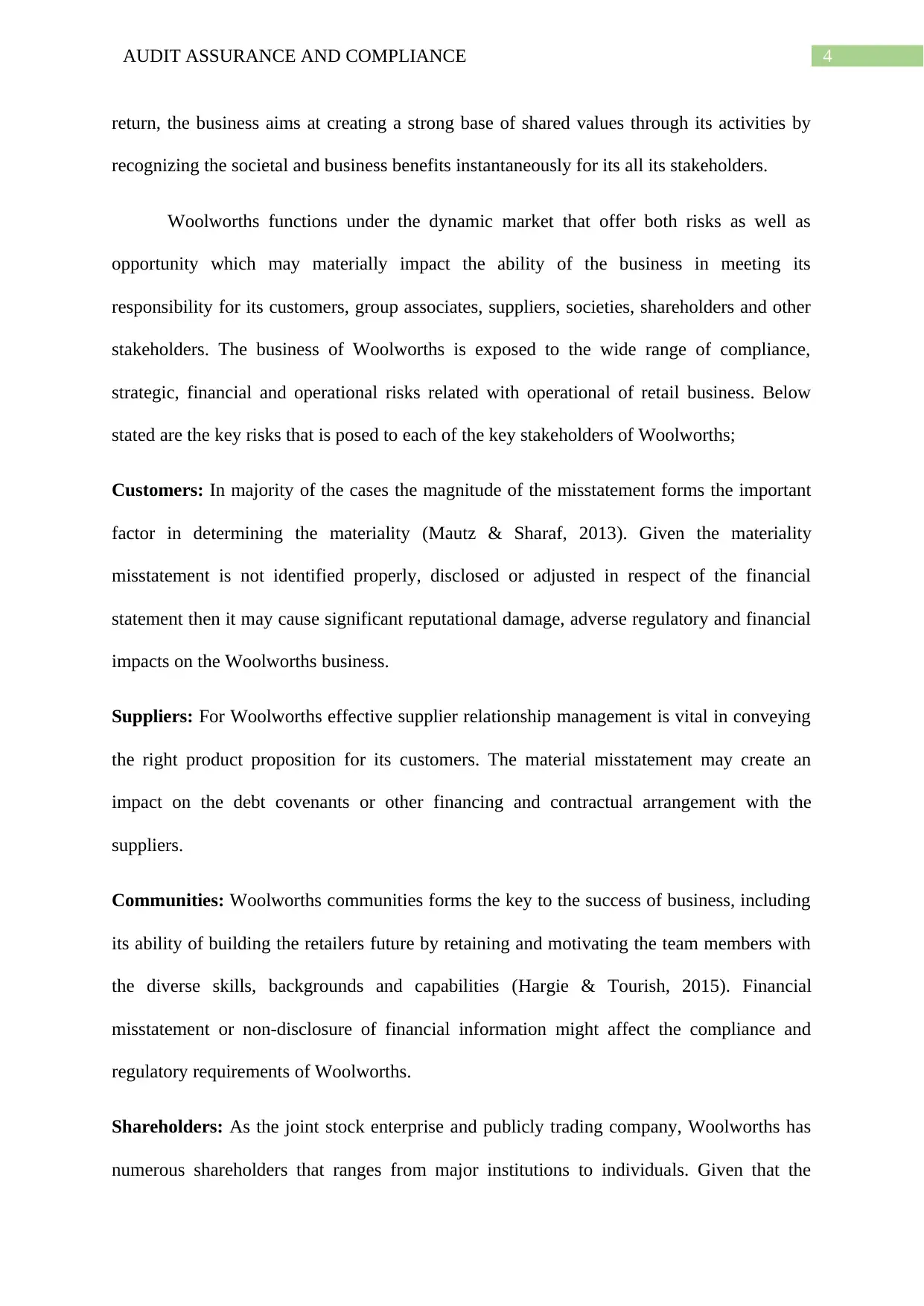
4AUDIT ASSURANCE AND COMPLIANCE
return, the business aims at creating a strong base of shared values through its activities by
recognizing the societal and business benefits instantaneously for its all its stakeholders.
Woolworths functions under the dynamic market that offer both risks as well as
opportunity which may materially impact the ability of the business in meeting its
responsibility for its customers, group associates, suppliers, societies, shareholders and other
stakeholders. The business of Woolworths is exposed to the wide range of compliance,
strategic, financial and operational risks related with operational of retail business. Below
stated are the key risks that is posed to each of the key stakeholders of Woolworths;
Customers: In majority of the cases the magnitude of the misstatement forms the important
factor in determining the materiality (Mautz & Sharaf, 2013). Given the materiality
misstatement is not identified properly, disclosed or adjusted in respect of the financial
statement then it may cause significant reputational damage, adverse regulatory and financial
impacts on the Woolworths business.
Suppliers: For Woolworths effective supplier relationship management is vital in conveying
the right product proposition for its customers. The material misstatement may create an
impact on the debt covenants or other financing and contractual arrangement with the
suppliers.
Communities: Woolworths communities forms the key to the success of business, including
its ability of building the retailers future by retaining and motivating the team members with
the diverse skills, backgrounds and capabilities (Hargie & Tourish, 2015). Financial
misstatement or non-disclosure of financial information might affect the compliance and
regulatory requirements of Woolworths.
Shareholders: As the joint stock enterprise and publicly trading company, Woolworths has
numerous shareholders that ranges from major institutions to individuals. Given that the
return, the business aims at creating a strong base of shared values through its activities by
recognizing the societal and business benefits instantaneously for its all its stakeholders.
Woolworths functions under the dynamic market that offer both risks as well as
opportunity which may materially impact the ability of the business in meeting its
responsibility for its customers, group associates, suppliers, societies, shareholders and other
stakeholders. The business of Woolworths is exposed to the wide range of compliance,
strategic, financial and operational risks related with operational of retail business. Below
stated are the key risks that is posed to each of the key stakeholders of Woolworths;
Customers: In majority of the cases the magnitude of the misstatement forms the important
factor in determining the materiality (Mautz & Sharaf, 2013). Given the materiality
misstatement is not identified properly, disclosed or adjusted in respect of the financial
statement then it may cause significant reputational damage, adverse regulatory and financial
impacts on the Woolworths business.
Suppliers: For Woolworths effective supplier relationship management is vital in conveying
the right product proposition for its customers. The material misstatement may create an
impact on the debt covenants or other financing and contractual arrangement with the
suppliers.
Communities: Woolworths communities forms the key to the success of business, including
its ability of building the retailers future by retaining and motivating the team members with
the diverse skills, backgrounds and capabilities (Hargie & Tourish, 2015). Financial
misstatement or non-disclosure of financial information might affect the compliance and
regulatory requirements of Woolworths.
Shareholders: As the joint stock enterprise and publicly trading company, Woolworths has
numerous shareholders that ranges from major institutions to individuals. Given that the
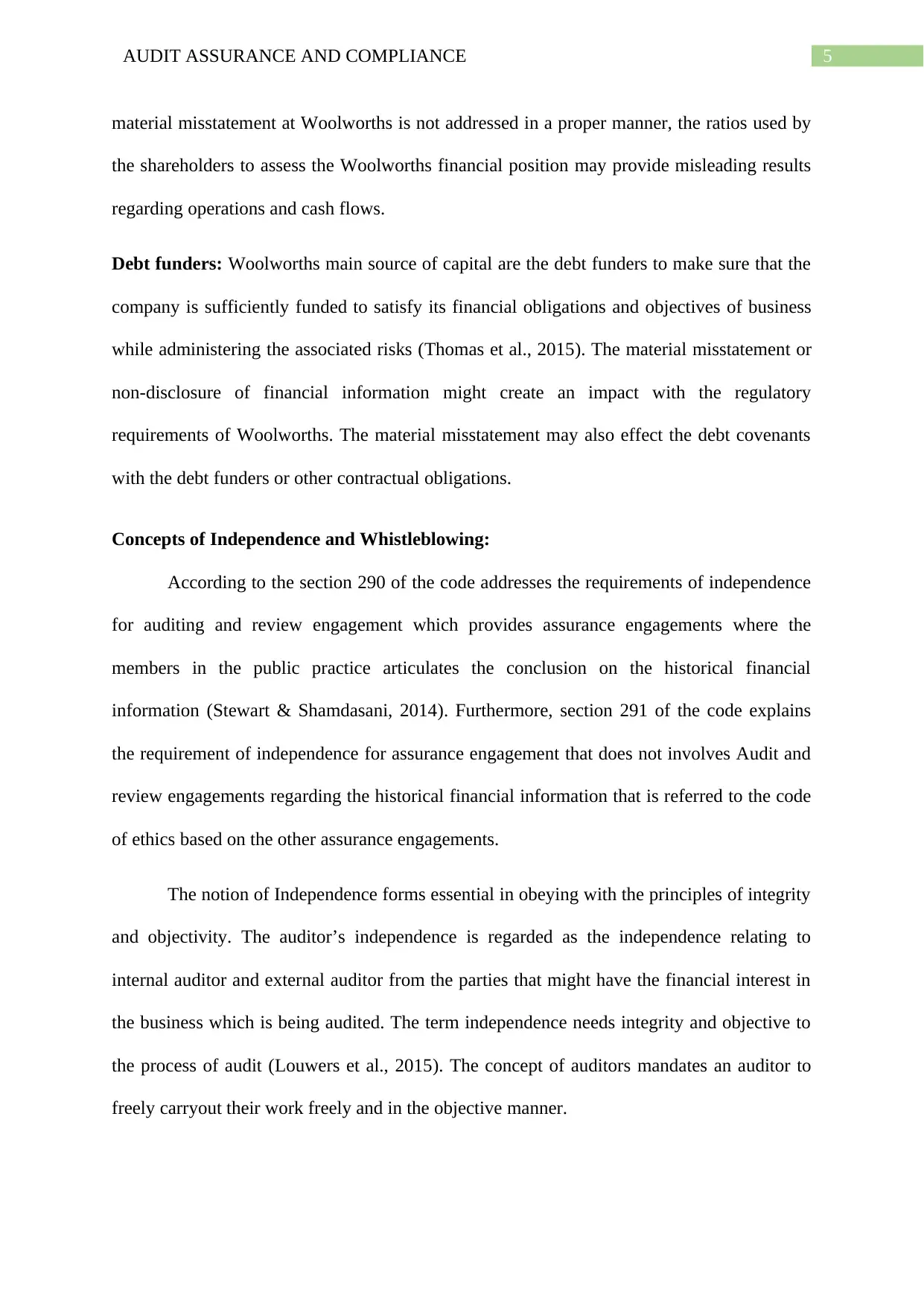
5AUDIT ASSURANCE AND COMPLIANCE
material misstatement at Woolworths is not addressed in a proper manner, the ratios used by
the shareholders to assess the Woolworths financial position may provide misleading results
regarding operations and cash flows.
Debt funders: Woolworths main source of capital are the debt funders to make sure that the
company is sufficiently funded to satisfy its financial obligations and objectives of business
while administering the associated risks (Thomas et al., 2015). The material misstatement or
non-disclosure of financial information might create an impact with the regulatory
requirements of Woolworths. The material misstatement may also effect the debt covenants
with the debt funders or other contractual obligations.
Concepts of Independence and Whistleblowing:
According to the section 290 of the code addresses the requirements of independence
for auditing and review engagement which provides assurance engagements where the
members in the public practice articulates the conclusion on the historical financial
information (Stewart & Shamdasani, 2014). Furthermore, section 291 of the code explains
the requirement of independence for assurance engagement that does not involves Audit and
review engagements regarding the historical financial information that is referred to the code
of ethics based on the other assurance engagements.
The notion of Independence forms essential in obeying with the principles of integrity
and objectivity. The auditor’s independence is regarded as the independence relating to
internal auditor and external auditor from the parties that might have the financial interest in
the business which is being audited. The term independence needs integrity and objective to
the process of audit (Louwers et al., 2015). The concept of auditors mandates an auditor to
freely carryout their work freely and in the objective manner.
material misstatement at Woolworths is not addressed in a proper manner, the ratios used by
the shareholders to assess the Woolworths financial position may provide misleading results
regarding operations and cash flows.
Debt funders: Woolworths main source of capital are the debt funders to make sure that the
company is sufficiently funded to satisfy its financial obligations and objectives of business
while administering the associated risks (Thomas et al., 2015). The material misstatement or
non-disclosure of financial information might create an impact with the regulatory
requirements of Woolworths. The material misstatement may also effect the debt covenants
with the debt funders or other contractual obligations.
Concepts of Independence and Whistleblowing:
According to the section 290 of the code addresses the requirements of independence
for auditing and review engagement which provides assurance engagements where the
members in the public practice articulates the conclusion on the historical financial
information (Stewart & Shamdasani, 2014). Furthermore, section 291 of the code explains
the requirement of independence for assurance engagement that does not involves Audit and
review engagements regarding the historical financial information that is referred to the code
of ethics based on the other assurance engagements.
The notion of Independence forms essential in obeying with the principles of integrity
and objectivity. The auditor’s independence is regarded as the independence relating to
internal auditor and external auditor from the parties that might have the financial interest in
the business which is being audited. The term independence needs integrity and objective to
the process of audit (Louwers et al., 2015). The concept of auditors mandates an auditor to
freely carryout their work freely and in the objective manner.
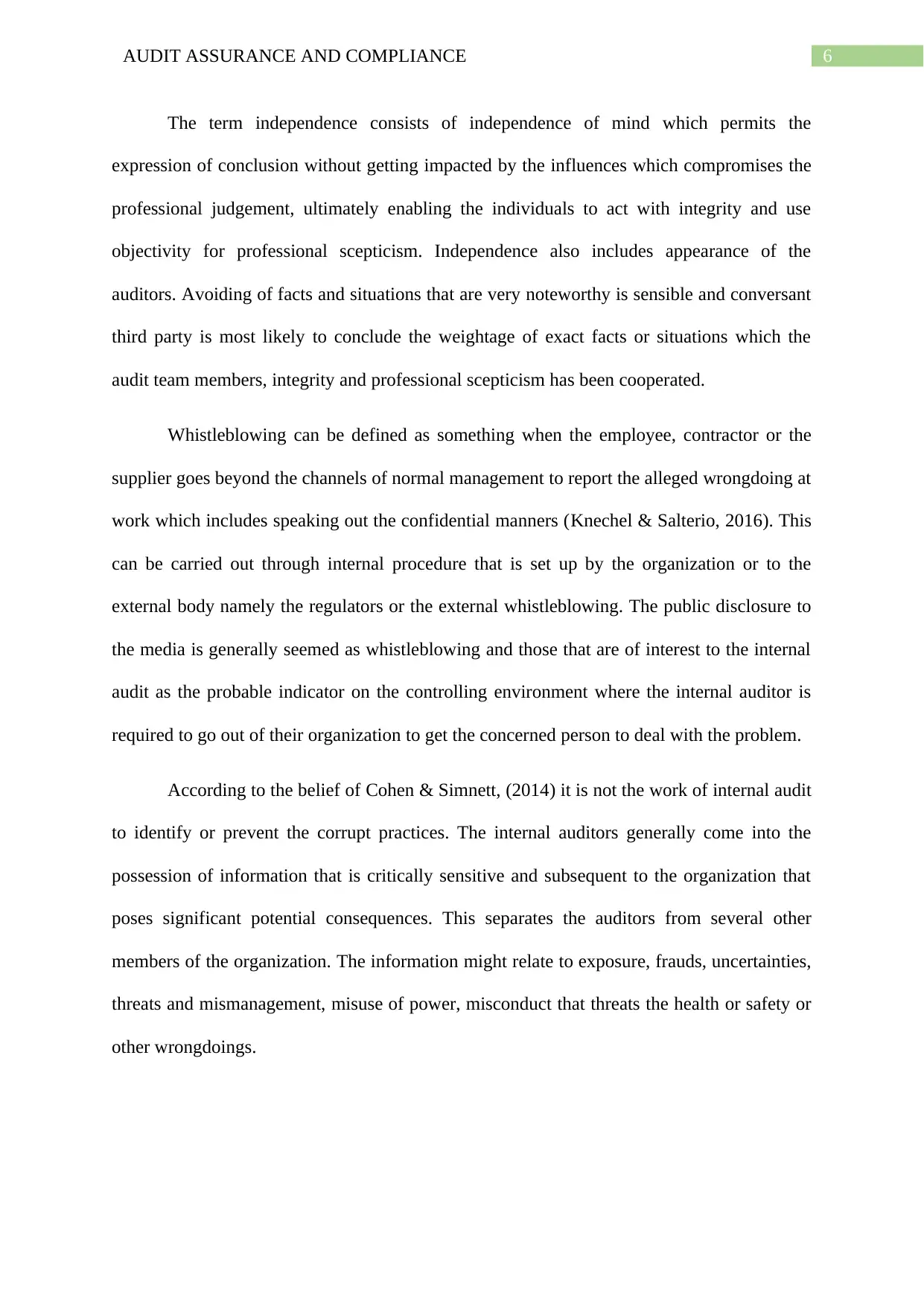
6AUDIT ASSURANCE AND COMPLIANCE
The term independence consists of independence of mind which permits the
expression of conclusion without getting impacted by the influences which compromises the
professional judgement, ultimately enabling the individuals to act with integrity and use
objectivity for professional scepticism. Independence also includes appearance of the
auditors. Avoiding of facts and situations that are very noteworthy is sensible and conversant
third party is most likely to conclude the weightage of exact facts or situations which the
audit team members, integrity and professional scepticism has been cooperated.
Whistleblowing can be defined as something when the employee, contractor or the
supplier goes beyond the channels of normal management to report the alleged wrongdoing at
work which includes speaking out the confidential manners (Knechel & Salterio, 2016). This
can be carried out through internal procedure that is set up by the organization or to the
external body namely the regulators or the external whistleblowing. The public disclosure to
the media is generally seemed as whistleblowing and those that are of interest to the internal
audit as the probable indicator on the controlling environment where the internal auditor is
required to go out of their organization to get the concerned person to deal with the problem.
According to the belief of Cohen & Simnett, (2014) it is not the work of internal audit
to identify or prevent the corrupt practices. The internal auditors generally come into the
possession of information that is critically sensitive and subsequent to the organization that
poses significant potential consequences. This separates the auditors from several other
members of the organization. The information might relate to exposure, frauds, uncertainties,
threats and mismanagement, misuse of power, misconduct that threats the health or safety or
other wrongdoings.
The term independence consists of independence of mind which permits the
expression of conclusion without getting impacted by the influences which compromises the
professional judgement, ultimately enabling the individuals to act with integrity and use
objectivity for professional scepticism. Independence also includes appearance of the
auditors. Avoiding of facts and situations that are very noteworthy is sensible and conversant
third party is most likely to conclude the weightage of exact facts or situations which the
audit team members, integrity and professional scepticism has been cooperated.
Whistleblowing can be defined as something when the employee, contractor or the
supplier goes beyond the channels of normal management to report the alleged wrongdoing at
work which includes speaking out the confidential manners (Knechel & Salterio, 2016). This
can be carried out through internal procedure that is set up by the organization or to the
external body namely the regulators or the external whistleblowing. The public disclosure to
the media is generally seemed as whistleblowing and those that are of interest to the internal
audit as the probable indicator on the controlling environment where the internal auditor is
required to go out of their organization to get the concerned person to deal with the problem.
According to the belief of Cohen & Simnett, (2014) it is not the work of internal audit
to identify or prevent the corrupt practices. The internal auditors generally come into the
possession of information that is critically sensitive and subsequent to the organization that
poses significant potential consequences. This separates the auditors from several other
members of the organization. The information might relate to exposure, frauds, uncertainties,
threats and mismanagement, misuse of power, misconduct that threats the health or safety or
other wrongdoings.
Paraphrase This Document
Need a fresh take? Get an instant paraphrase of this document with our AI Paraphraser
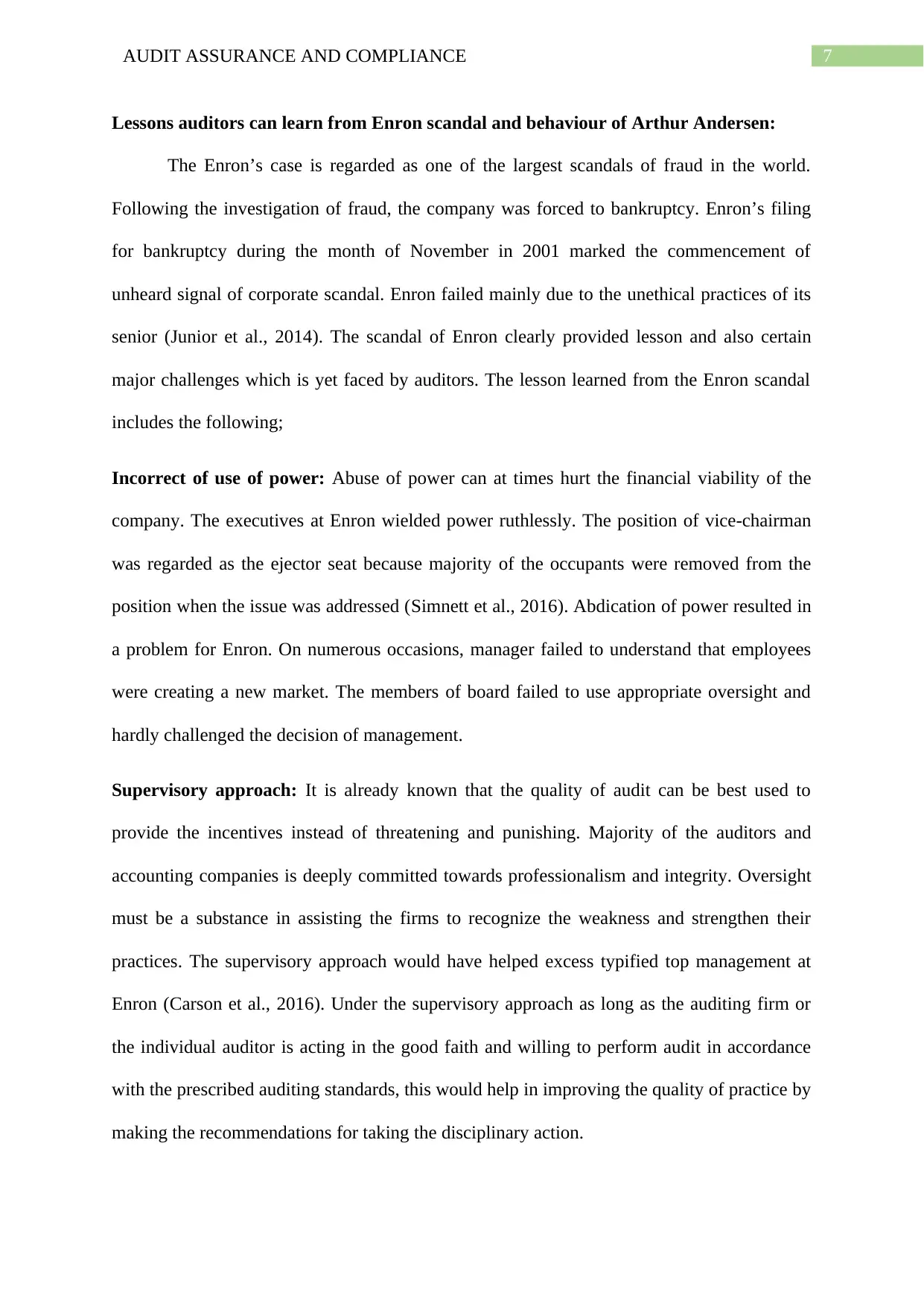
7AUDIT ASSURANCE AND COMPLIANCE
Lessons auditors can learn from Enron scandal and behaviour of Arthur Andersen:
The Enron’s case is regarded as one of the largest scandals of fraud in the world.
Following the investigation of fraud, the company was forced to bankruptcy. Enron’s filing
for bankruptcy during the month of November in 2001 marked the commencement of
unheard signal of corporate scandal. Enron failed mainly due to the unethical practices of its
senior (Junior et al., 2014). The scandal of Enron clearly provided lesson and also certain
major challenges which is yet faced by auditors. The lesson learned from the Enron scandal
includes the following;
Incorrect of use of power: Abuse of power can at times hurt the financial viability of the
company. The executives at Enron wielded power ruthlessly. The position of vice-chairman
was regarded as the ejector seat because majority of the occupants were removed from the
position when the issue was addressed (Simnett et al., 2016). Abdication of power resulted in
a problem for Enron. On numerous occasions, manager failed to understand that employees
were creating a new market. The members of board failed to use appropriate oversight and
hardly challenged the decision of management.
Supervisory approach: It is already known that the quality of audit can be best used to
provide the incentives instead of threatening and punishing. Majority of the auditors and
accounting companies is deeply committed towards professionalism and integrity. Oversight
must be a substance in assisting the firms to recognize the weakness and strengthen their
practices. The supervisory approach would have helped excess typified top management at
Enron (Carson et al., 2016). Under the supervisory approach as long as the auditing firm or
the individual auditor is acting in the good faith and willing to perform audit in accordance
with the prescribed auditing standards, this would help in improving the quality of practice by
making the recommendations for taking the disciplinary action.
Lessons auditors can learn from Enron scandal and behaviour of Arthur Andersen:
The Enron’s case is regarded as one of the largest scandals of fraud in the world.
Following the investigation of fraud, the company was forced to bankruptcy. Enron’s filing
for bankruptcy during the month of November in 2001 marked the commencement of
unheard signal of corporate scandal. Enron failed mainly due to the unethical practices of its
senior (Junior et al., 2014). The scandal of Enron clearly provided lesson and also certain
major challenges which is yet faced by auditors. The lesson learned from the Enron scandal
includes the following;
Incorrect of use of power: Abuse of power can at times hurt the financial viability of the
company. The executives at Enron wielded power ruthlessly. The position of vice-chairman
was regarded as the ejector seat because majority of the occupants were removed from the
position when the issue was addressed (Simnett et al., 2016). Abdication of power resulted in
a problem for Enron. On numerous occasions, manager failed to understand that employees
were creating a new market. The members of board failed to use appropriate oversight and
hardly challenged the decision of management.
Supervisory approach: It is already known that the quality of audit can be best used to
provide the incentives instead of threatening and punishing. Majority of the auditors and
accounting companies is deeply committed towards professionalism and integrity. Oversight
must be a substance in assisting the firms to recognize the weakness and strengthen their
practices. The supervisory approach would have helped excess typified top management at
Enron (Carson et al., 2016). Under the supervisory approach as long as the auditing firm or
the individual auditor is acting in the good faith and willing to perform audit in accordance
with the prescribed auditing standards, this would help in improving the quality of practice by
making the recommendations for taking the disciplinary action.
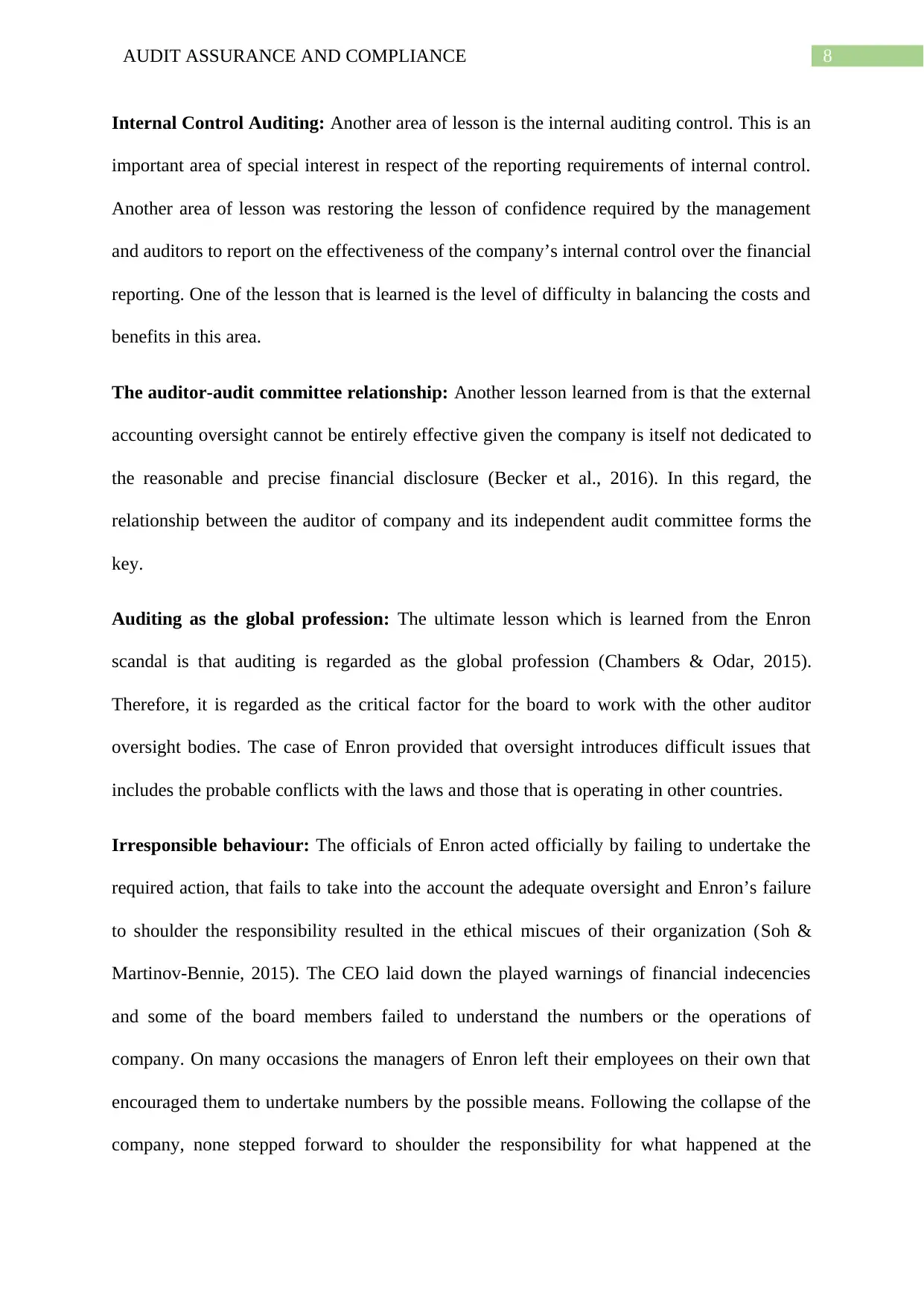
8AUDIT ASSURANCE AND COMPLIANCE
Internal Control Auditing: Another area of lesson is the internal auditing control. This is an
important area of special interest in respect of the reporting requirements of internal control.
Another area of lesson was restoring the lesson of confidence required by the management
and auditors to report on the effectiveness of the company’s internal control over the financial
reporting. One of the lesson that is learned is the level of difficulty in balancing the costs and
benefits in this area.
The auditor-audit committee relationship: Another lesson learned from is that the external
accounting oversight cannot be entirely effective given the company is itself not dedicated to
the reasonable and precise financial disclosure (Becker et al., 2016). In this regard, the
relationship between the auditor of company and its independent audit committee forms the
key.
Auditing as the global profession: The ultimate lesson which is learned from the Enron
scandal is that auditing is regarded as the global profession (Chambers & Odar, 2015).
Therefore, it is regarded as the critical factor for the board to work with the other auditor
oversight bodies. The case of Enron provided that oversight introduces difficult issues that
includes the probable conflicts with the laws and those that is operating in other countries.
Irresponsible behaviour: The officials of Enron acted officially by failing to undertake the
required action, that fails to take into the account the adequate oversight and Enron’s failure
to shoulder the responsibility resulted in the ethical miscues of their organization (Soh &
Martinov-Bennie, 2015). The CEO laid down the played warnings of financial indecencies
and some of the board members failed to understand the numbers or the operations of
company. On many occasions the managers of Enron left their employees on their own that
encouraged them to undertake numbers by the possible means. Following the collapse of the
company, none stepped forward to shoulder the responsibility for what happened at the
Internal Control Auditing: Another area of lesson is the internal auditing control. This is an
important area of special interest in respect of the reporting requirements of internal control.
Another area of lesson was restoring the lesson of confidence required by the management
and auditors to report on the effectiveness of the company’s internal control over the financial
reporting. One of the lesson that is learned is the level of difficulty in balancing the costs and
benefits in this area.
The auditor-audit committee relationship: Another lesson learned from is that the external
accounting oversight cannot be entirely effective given the company is itself not dedicated to
the reasonable and precise financial disclosure (Becker et al., 2016). In this regard, the
relationship between the auditor of company and its independent audit committee forms the
key.
Auditing as the global profession: The ultimate lesson which is learned from the Enron
scandal is that auditing is regarded as the global profession (Chambers & Odar, 2015).
Therefore, it is regarded as the critical factor for the board to work with the other auditor
oversight bodies. The case of Enron provided that oversight introduces difficult issues that
includes the probable conflicts with the laws and those that is operating in other countries.
Irresponsible behaviour: The officials of Enron acted officially by failing to undertake the
required action, that fails to take into the account the adequate oversight and Enron’s failure
to shoulder the responsibility resulted in the ethical miscues of their organization (Soh &
Martinov-Bennie, 2015). The CEO laid down the played warnings of financial indecencies
and some of the board members failed to understand the numbers or the operations of
company. On many occasions the managers of Enron left their employees on their own that
encouraged them to undertake numbers by the possible means. Following the collapse of the
company, none stepped forward to shoulder the responsibility for what happened at the
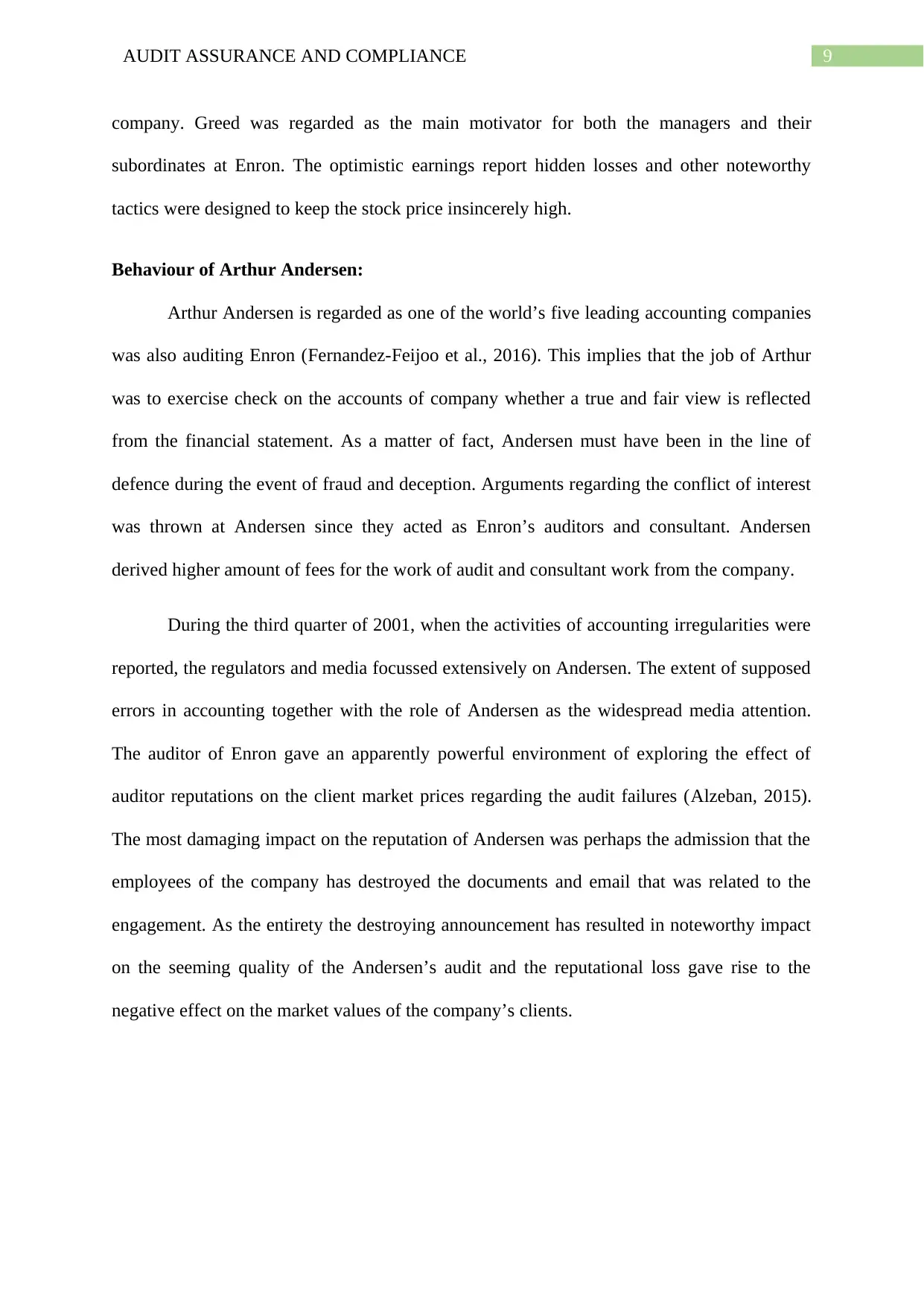
9AUDIT ASSURANCE AND COMPLIANCE
company. Greed was regarded as the main motivator for both the managers and their
subordinates at Enron. The optimistic earnings report hidden losses and other noteworthy
tactics were designed to keep the stock price insincerely high.
Behaviour of Arthur Andersen:
Arthur Andersen is regarded as one of the world’s five leading accounting companies
was also auditing Enron (Fernandez-Feijoo et al., 2016). This implies that the job of Arthur
was to exercise check on the accounts of company whether a true and fair view is reflected
from the financial statement. As a matter of fact, Andersen must have been in the line of
defence during the event of fraud and deception. Arguments regarding the conflict of interest
was thrown at Andersen since they acted as Enron’s auditors and consultant. Andersen
derived higher amount of fees for the work of audit and consultant work from the company.
During the third quarter of 2001, when the activities of accounting irregularities were
reported, the regulators and media focussed extensively on Andersen. The extent of supposed
errors in accounting together with the role of Andersen as the widespread media attention.
The auditor of Enron gave an apparently powerful environment of exploring the effect of
auditor reputations on the client market prices regarding the audit failures (Alzeban, 2015).
The most damaging impact on the reputation of Andersen was perhaps the admission that the
employees of the company has destroyed the documents and email that was related to the
engagement. As the entirety the destroying announcement has resulted in noteworthy impact
on the seeming quality of the Andersen’s audit and the reputational loss gave rise to the
negative effect on the market values of the company’s clients.
company. Greed was regarded as the main motivator for both the managers and their
subordinates at Enron. The optimistic earnings report hidden losses and other noteworthy
tactics were designed to keep the stock price insincerely high.
Behaviour of Arthur Andersen:
Arthur Andersen is regarded as one of the world’s five leading accounting companies
was also auditing Enron (Fernandez-Feijoo et al., 2016). This implies that the job of Arthur
was to exercise check on the accounts of company whether a true and fair view is reflected
from the financial statement. As a matter of fact, Andersen must have been in the line of
defence during the event of fraud and deception. Arguments regarding the conflict of interest
was thrown at Andersen since they acted as Enron’s auditors and consultant. Andersen
derived higher amount of fees for the work of audit and consultant work from the company.
During the third quarter of 2001, when the activities of accounting irregularities were
reported, the regulators and media focussed extensively on Andersen. The extent of supposed
errors in accounting together with the role of Andersen as the widespread media attention.
The auditor of Enron gave an apparently powerful environment of exploring the effect of
auditor reputations on the client market prices regarding the audit failures (Alzeban, 2015).
The most damaging impact on the reputation of Andersen was perhaps the admission that the
employees of the company has destroyed the documents and email that was related to the
engagement. As the entirety the destroying announcement has resulted in noteworthy impact
on the seeming quality of the Andersen’s audit and the reputational loss gave rise to the
negative effect on the market values of the company’s clients.
Secure Best Marks with AI Grader
Need help grading? Try our AI Grader for instant feedback on your assignments.

10AUDIT ASSURANCE AND COMPLIANCE
Audit Quality and discussion of auditors need in addressing the waring noted by Greg
Medcraft:
In the statement made by the Greg Medcraft Australia might be facing the Enron type
business collapse except the big four accounting companies significantly improve their
standards of auditing as warned by the chairman of ASIC (ABC News, 2018). According to
the statement made by Greg Medcraft the practice of poor auditing of the company accounts
may act as the canary in the coal mine till the next financial crisis.
According to Greg Medcraft another Enron might soon be in the making. However,
the key of not having another Enron is to assure that the auditors perform their work and
obtain assurance that the financial statement does not has the material misstatement. Greg
Medcraft also expressed his fear that he no longer has trust in the financial information
(Apesb.org.au, 2018). He recalls that the investigation of Enron’s collapse invited financial
crisis in the major area of audit. According to Greg Medcraft, he stated that the extent of trust
the society can have on the financial statement is meant to be guaranteed by the auditors.
In the recent study conducted by the ASIC, the samples collected from the key audits
of KPMG, PWC, Deloitte and E & Y over the past eighteen months till December 2018, 23
per cent of the audit did not offered any reasonable assurance that the books of accounts are
accurate or free from any material misstatement (Carson et al., 2017). Evidences from the
findings suggest that there was the lack of scepticism and usually lacked the approach of
challenging that was faced by the company. When it was asked that the poor auditing was the
canary in the coal mine, Greg Medcraft warned that there was noteworthy red flag and with
passage of time it was turning out to be worse.
The US-based firm Enron collapsed spectacularly during the year 2002 in the scandal
and planned the accounting fraud in a creative manner. This ultimately resulted in the demise
Audit Quality and discussion of auditors need in addressing the waring noted by Greg
Medcraft:
In the statement made by the Greg Medcraft Australia might be facing the Enron type
business collapse except the big four accounting companies significantly improve their
standards of auditing as warned by the chairman of ASIC (ABC News, 2018). According to
the statement made by Greg Medcraft the practice of poor auditing of the company accounts
may act as the canary in the coal mine till the next financial crisis.
According to Greg Medcraft another Enron might soon be in the making. However,
the key of not having another Enron is to assure that the auditors perform their work and
obtain assurance that the financial statement does not has the material misstatement. Greg
Medcraft also expressed his fear that he no longer has trust in the financial information
(Apesb.org.au, 2018). He recalls that the investigation of Enron’s collapse invited financial
crisis in the major area of audit. According to Greg Medcraft, he stated that the extent of trust
the society can have on the financial statement is meant to be guaranteed by the auditors.
In the recent study conducted by the ASIC, the samples collected from the key audits
of KPMG, PWC, Deloitte and E & Y over the past eighteen months till December 2018, 23
per cent of the audit did not offered any reasonable assurance that the books of accounts are
accurate or free from any material misstatement (Carson et al., 2017). Evidences from the
findings suggest that there was the lack of scepticism and usually lacked the approach of
challenging that was faced by the company. When it was asked that the poor auditing was the
canary in the coal mine, Greg Medcraft warned that there was noteworthy red flag and with
passage of time it was turning out to be worse.
The US-based firm Enron collapsed spectacularly during the year 2002 in the scandal
and planned the accounting fraud in a creative manner. This ultimately resulted in the demise
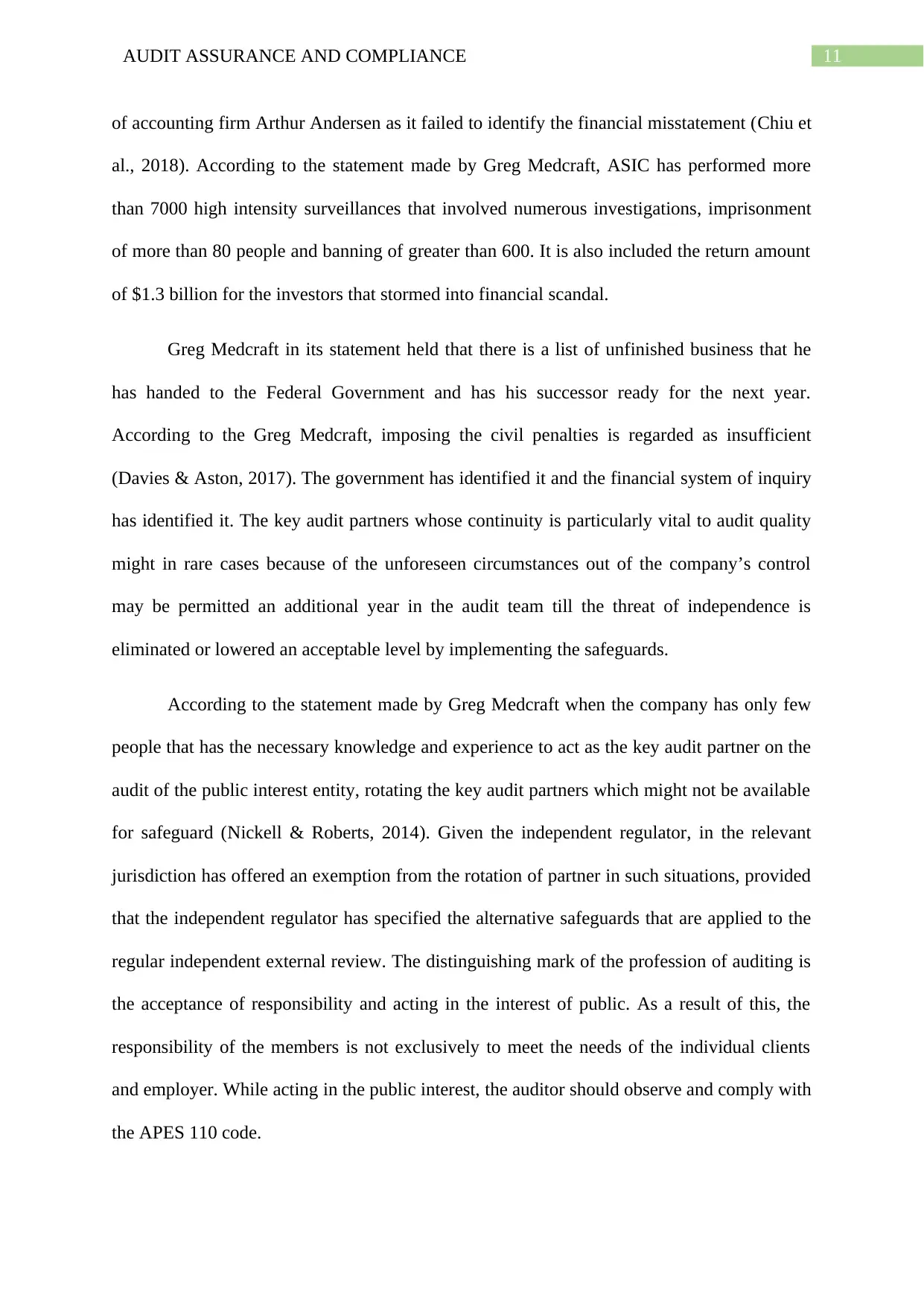
11AUDIT ASSURANCE AND COMPLIANCE
of accounting firm Arthur Andersen as it failed to identify the financial misstatement (Chiu et
al., 2018). According to the statement made by Greg Medcraft, ASIC has performed more
than 7000 high intensity surveillances that involved numerous investigations, imprisonment
of more than 80 people and banning of greater than 600. It is also included the return amount
of $1.3 billion for the investors that stormed into financial scandal.
Greg Medcraft in its statement held that there is a list of unfinished business that he
has handed to the Federal Government and has his successor ready for the next year.
According to the Greg Medcraft, imposing the civil penalties is regarded as insufficient
(Davies & Aston, 2017). The government has identified it and the financial system of inquiry
has identified it. The key audit partners whose continuity is particularly vital to audit quality
might in rare cases because of the unforeseen circumstances out of the company’s control
may be permitted an additional year in the audit team till the threat of independence is
eliminated or lowered an acceptable level by implementing the safeguards.
According to the statement made by Greg Medcraft when the company has only few
people that has the necessary knowledge and experience to act as the key audit partner on the
audit of the public interest entity, rotating the key audit partners which might not be available
for safeguard (Nickell & Roberts, 2014). Given the independent regulator, in the relevant
jurisdiction has offered an exemption from the rotation of partner in such situations, provided
that the independent regulator has specified the alternative safeguards that are applied to the
regular independent external review. The distinguishing mark of the profession of auditing is
the acceptance of responsibility and acting in the interest of public. As a result of this, the
responsibility of the members is not exclusively to meet the needs of the individual clients
and employer. While acting in the public interest, the auditor should observe and comply with
the APES 110 code.
of accounting firm Arthur Andersen as it failed to identify the financial misstatement (Chiu et
al., 2018). According to the statement made by Greg Medcraft, ASIC has performed more
than 7000 high intensity surveillances that involved numerous investigations, imprisonment
of more than 80 people and banning of greater than 600. It is also included the return amount
of $1.3 billion for the investors that stormed into financial scandal.
Greg Medcraft in its statement held that there is a list of unfinished business that he
has handed to the Federal Government and has his successor ready for the next year.
According to the Greg Medcraft, imposing the civil penalties is regarded as insufficient
(Davies & Aston, 2017). The government has identified it and the financial system of inquiry
has identified it. The key audit partners whose continuity is particularly vital to audit quality
might in rare cases because of the unforeseen circumstances out of the company’s control
may be permitted an additional year in the audit team till the threat of independence is
eliminated or lowered an acceptable level by implementing the safeguards.
According to the statement made by Greg Medcraft when the company has only few
people that has the necessary knowledge and experience to act as the key audit partner on the
audit of the public interest entity, rotating the key audit partners which might not be available
for safeguard (Nickell & Roberts, 2014). Given the independent regulator, in the relevant
jurisdiction has offered an exemption from the rotation of partner in such situations, provided
that the independent regulator has specified the alternative safeguards that are applied to the
regular independent external review. The distinguishing mark of the profession of auditing is
the acceptance of responsibility and acting in the interest of public. As a result of this, the
responsibility of the members is not exclusively to meet the needs of the individual clients
and employer. While acting in the public interest, the auditor should observe and comply with
the APES 110 code.
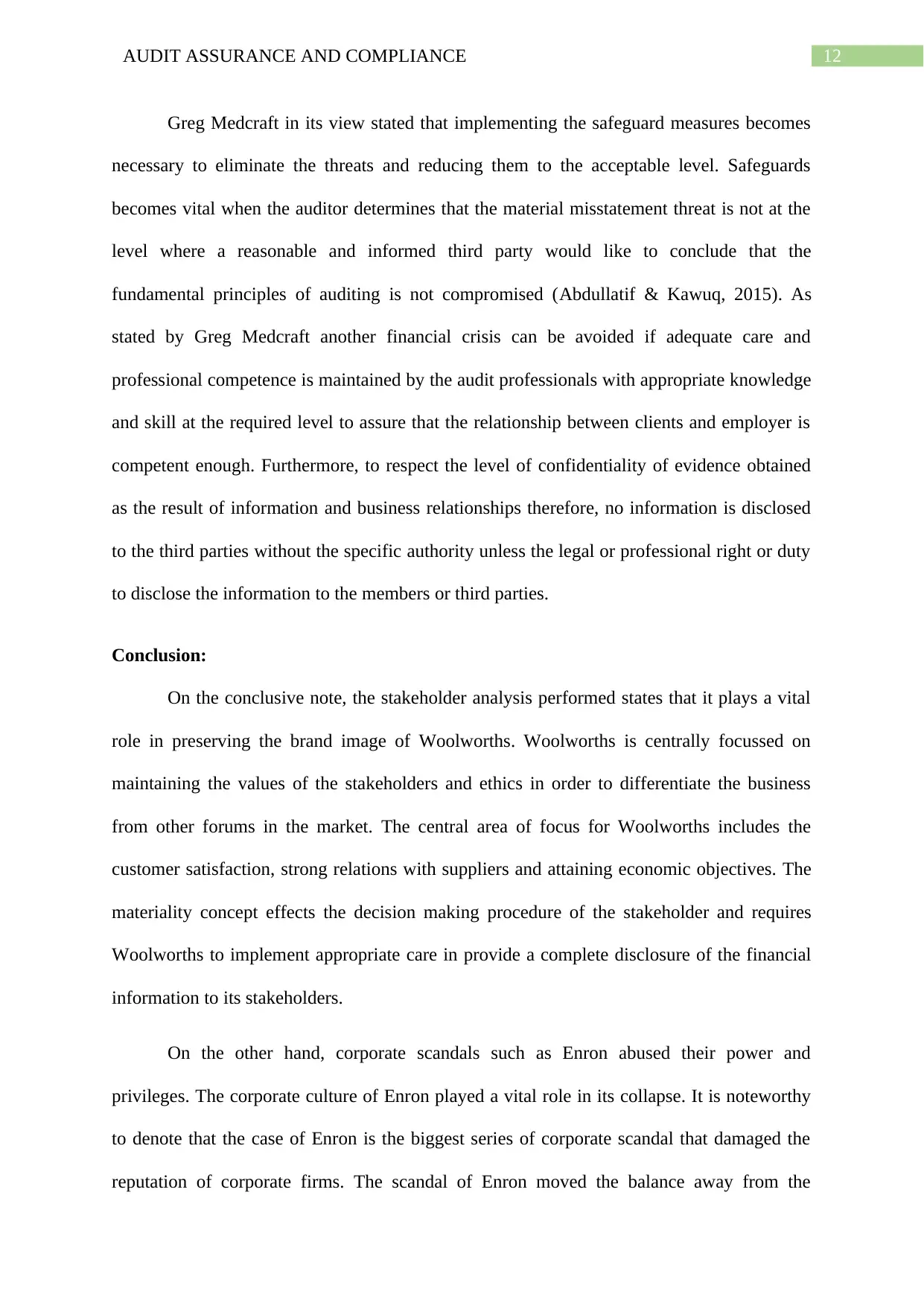
12AUDIT ASSURANCE AND COMPLIANCE
Greg Medcraft in its view stated that implementing the safeguard measures becomes
necessary to eliminate the threats and reducing them to the acceptable level. Safeguards
becomes vital when the auditor determines that the material misstatement threat is not at the
level where a reasonable and informed third party would like to conclude that the
fundamental principles of auditing is not compromised (Abdullatif & Kawuq, 2015). As
stated by Greg Medcraft another financial crisis can be avoided if adequate care and
professional competence is maintained by the audit professionals with appropriate knowledge
and skill at the required level to assure that the relationship between clients and employer is
competent enough. Furthermore, to respect the level of confidentiality of evidence obtained
as the result of information and business relationships therefore, no information is disclosed
to the third parties without the specific authority unless the legal or professional right or duty
to disclose the information to the members or third parties.
Conclusion:
On the conclusive note, the stakeholder analysis performed states that it plays a vital
role in preserving the brand image of Woolworths. Woolworths is centrally focussed on
maintaining the values of the stakeholders and ethics in order to differentiate the business
from other forums in the market. The central area of focus for Woolworths includes the
customer satisfaction, strong relations with suppliers and attaining economic objectives. The
materiality concept effects the decision making procedure of the stakeholder and requires
Woolworths to implement appropriate care in provide a complete disclosure of the financial
information to its stakeholders.
On the other hand, corporate scandals such as Enron abused their power and
privileges. The corporate culture of Enron played a vital role in its collapse. It is noteworthy
to denote that the case of Enron is the biggest series of corporate scandal that damaged the
reputation of corporate firms. The scandal of Enron moved the balance away from the
Greg Medcraft in its view stated that implementing the safeguard measures becomes
necessary to eliminate the threats and reducing them to the acceptable level. Safeguards
becomes vital when the auditor determines that the material misstatement threat is not at the
level where a reasonable and informed third party would like to conclude that the
fundamental principles of auditing is not compromised (Abdullatif & Kawuq, 2015). As
stated by Greg Medcraft another financial crisis can be avoided if adequate care and
professional competence is maintained by the audit professionals with appropriate knowledge
and skill at the required level to assure that the relationship between clients and employer is
competent enough. Furthermore, to respect the level of confidentiality of evidence obtained
as the result of information and business relationships therefore, no information is disclosed
to the third parties without the specific authority unless the legal or professional right or duty
to disclose the information to the members or third parties.
Conclusion:
On the conclusive note, the stakeholder analysis performed states that it plays a vital
role in preserving the brand image of Woolworths. Woolworths is centrally focussed on
maintaining the values of the stakeholders and ethics in order to differentiate the business
from other forums in the market. The central area of focus for Woolworths includes the
customer satisfaction, strong relations with suppliers and attaining economic objectives. The
materiality concept effects the decision making procedure of the stakeholder and requires
Woolworths to implement appropriate care in provide a complete disclosure of the financial
information to its stakeholders.
On the other hand, corporate scandals such as Enron abused their power and
privileges. The corporate culture of Enron played a vital role in its collapse. It is noteworthy
to denote that the case of Enron is the biggest series of corporate scandal that damaged the
reputation of corporate firms. The scandal of Enron moved the balance away from the
Paraphrase This Document
Need a fresh take? Get an instant paraphrase of this document with our AI Paraphraser
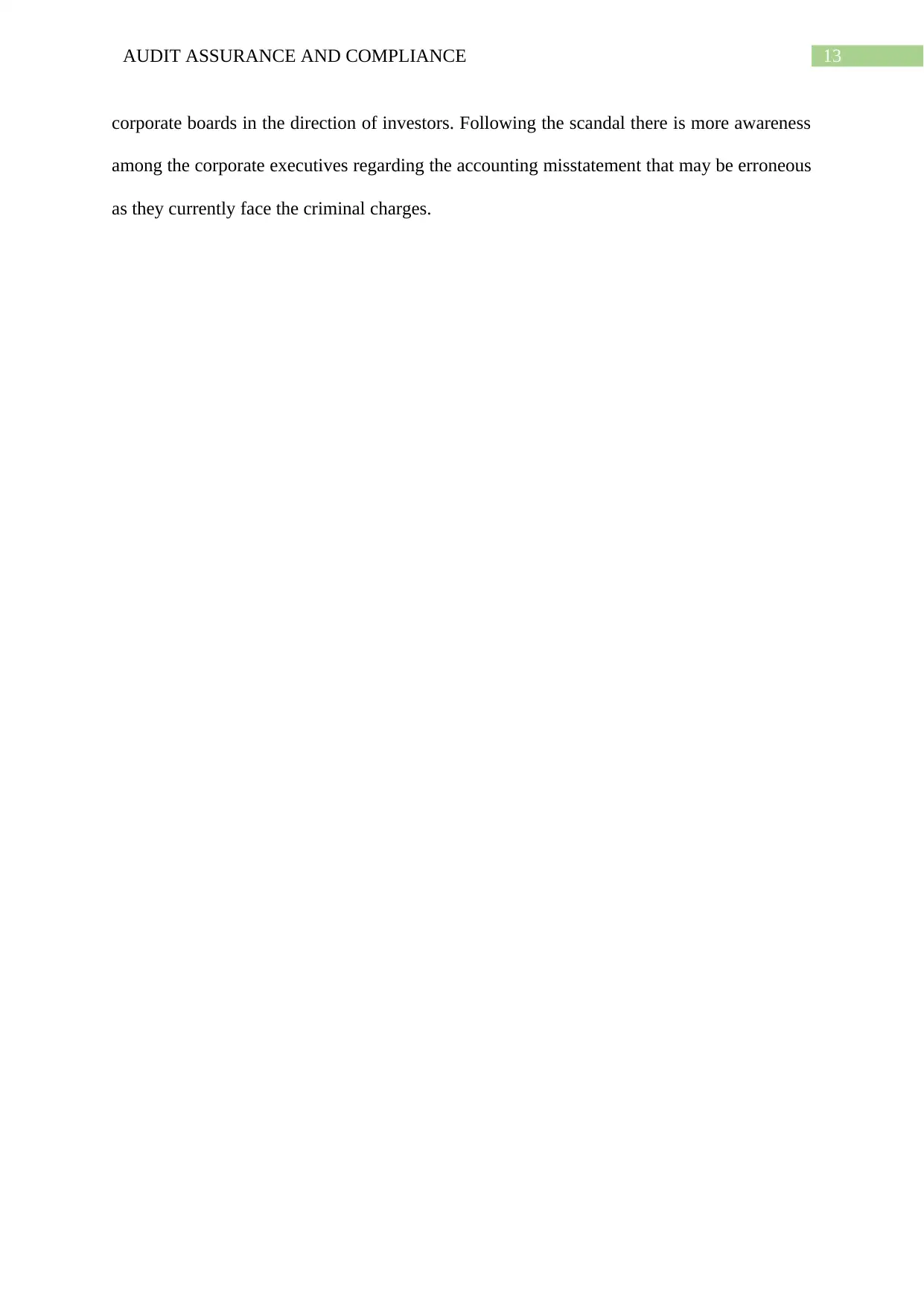
13AUDIT ASSURANCE AND COMPLIANCE
corporate boards in the direction of investors. Following the scandal there is more awareness
among the corporate executives regarding the accounting misstatement that may be erroneous
as they currently face the criminal charges.
corporate boards in the direction of investors. Following the scandal there is more awareness
among the corporate executives regarding the accounting misstatement that may be erroneous
as they currently face the criminal charges.
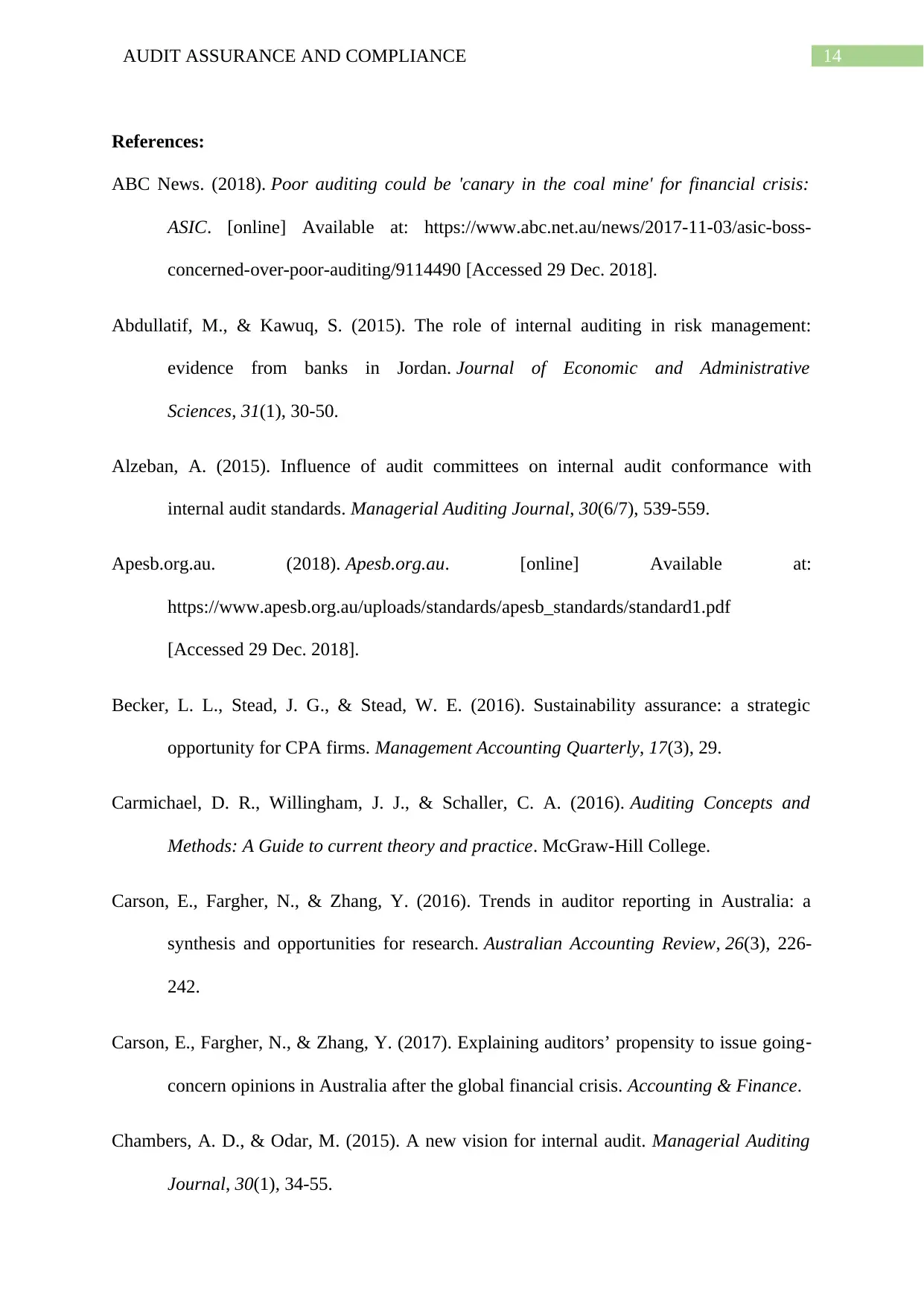
14AUDIT ASSURANCE AND COMPLIANCE
References:
ABC News. (2018). Poor auditing could be 'canary in the coal mine' for financial crisis:
ASIC. [online] Available at: https://www.abc.net.au/news/2017-11-03/asic-boss-
concerned-over-poor-auditing/9114490 [Accessed 29 Dec. 2018].
Abdullatif, M., & Kawuq, S. (2015). The role of internal auditing in risk management:
evidence from banks in Jordan. Journal of Economic and Administrative
Sciences, 31(1), 30-50.
Alzeban, A. (2015). Influence of audit committees on internal audit conformance with
internal audit standards. Managerial Auditing Journal, 30(6/7), 539-559.
Apesb.org.au. (2018). Apesb.org.au. [online] Available at:
https://www.apesb.org.au/uploads/standards/apesb_standards/standard1.pdf
[Accessed 29 Dec. 2018].
Becker, L. L., Stead, J. G., & Stead, W. E. (2016). Sustainability assurance: a strategic
opportunity for CPA firms. Management Accounting Quarterly, 17(3), 29.
Carmichael, D. R., Willingham, J. J., & Schaller, C. A. (2016). Auditing Concepts and
Methods: A Guide to current theory and practice. McGraw-Hill College.
Carson, E., Fargher, N., & Zhang, Y. (2016). Trends in auditor reporting in Australia: a
synthesis and opportunities for research. Australian Accounting Review, 26(3), 226-
242.
Carson, E., Fargher, N., & Zhang, Y. (2017). Explaining auditors’ propensity to issue going‐
concern opinions in Australia after the global financial crisis. Accounting & Finance.
Chambers, A. D., & Odar, M. (2015). A new vision for internal audit. Managerial Auditing
Journal, 30(1), 34-55.
References:
ABC News. (2018). Poor auditing could be 'canary in the coal mine' for financial crisis:
ASIC. [online] Available at: https://www.abc.net.au/news/2017-11-03/asic-boss-
concerned-over-poor-auditing/9114490 [Accessed 29 Dec. 2018].
Abdullatif, M., & Kawuq, S. (2015). The role of internal auditing in risk management:
evidence from banks in Jordan. Journal of Economic and Administrative
Sciences, 31(1), 30-50.
Alzeban, A. (2015). Influence of audit committees on internal audit conformance with
internal audit standards. Managerial Auditing Journal, 30(6/7), 539-559.
Apesb.org.au. (2018). Apesb.org.au. [online] Available at:
https://www.apesb.org.au/uploads/standards/apesb_standards/standard1.pdf
[Accessed 29 Dec. 2018].
Becker, L. L., Stead, J. G., & Stead, W. E. (2016). Sustainability assurance: a strategic
opportunity for CPA firms. Management Accounting Quarterly, 17(3), 29.
Carmichael, D. R., Willingham, J. J., & Schaller, C. A. (2016). Auditing Concepts and
Methods: A Guide to current theory and practice. McGraw-Hill College.
Carson, E., Fargher, N., & Zhang, Y. (2016). Trends in auditor reporting in Australia: a
synthesis and opportunities for research. Australian Accounting Review, 26(3), 226-
242.
Carson, E., Fargher, N., & Zhang, Y. (2017). Explaining auditors’ propensity to issue going‐
concern opinions in Australia after the global financial crisis. Accounting & Finance.
Chambers, A. D., & Odar, M. (2015). A new vision for internal audit. Managerial Auditing
Journal, 30(1), 34-55.
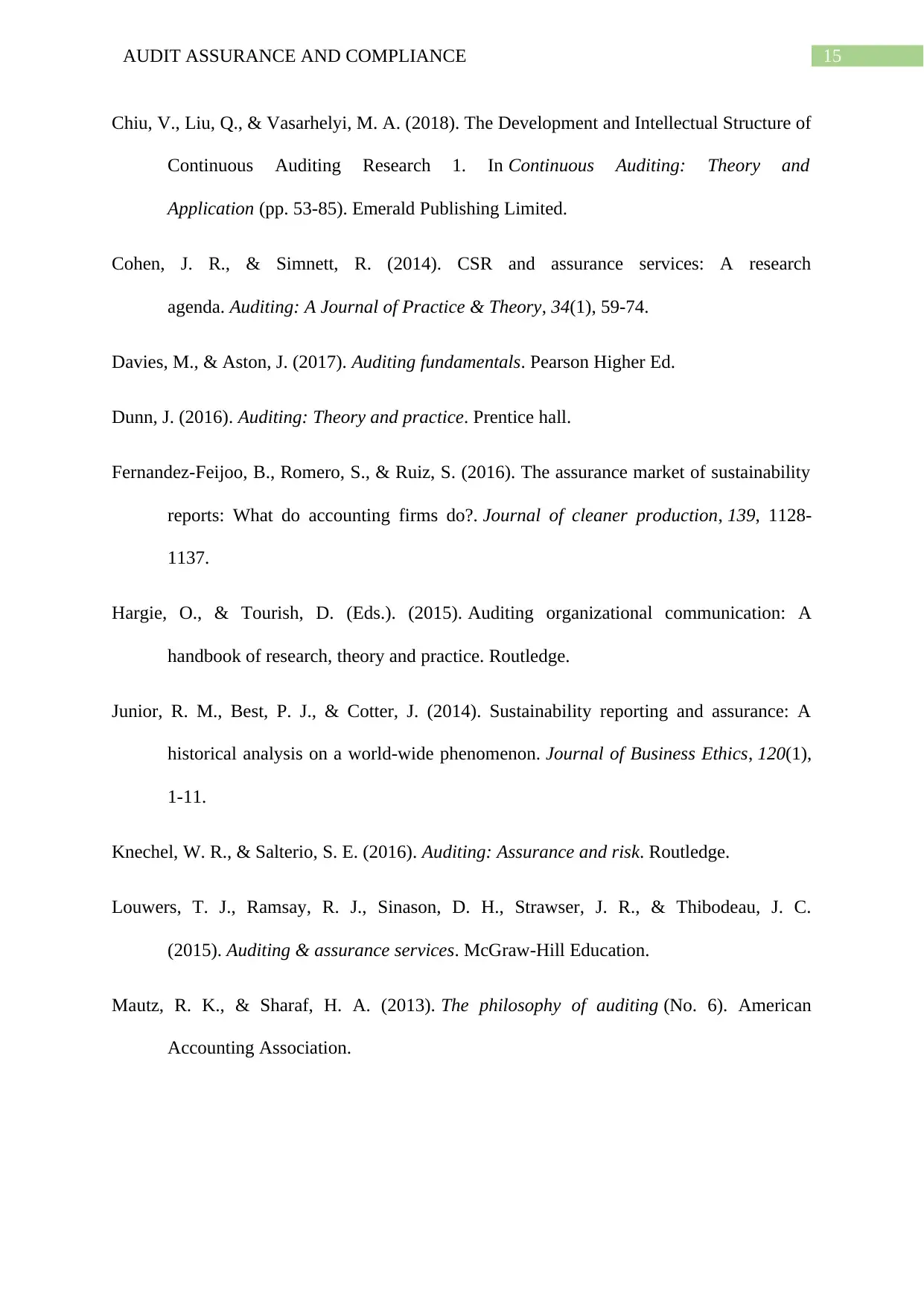
15AUDIT ASSURANCE AND COMPLIANCE
Chiu, V., Liu, Q., & Vasarhelyi, M. A. (2018). The Development and Intellectual Structure of
Continuous Auditing Research 1. In Continuous Auditing: Theory and
Application (pp. 53-85). Emerald Publishing Limited.
Cohen, J. R., & Simnett, R. (2014). CSR and assurance services: A research
agenda. Auditing: A Journal of Practice & Theory, 34(1), 59-74.
Davies, M., & Aston, J. (2017). Auditing fundamentals. Pearson Higher Ed.
Dunn, J. (2016). Auditing: Theory and practice. Prentice hall.
Fernandez-Feijoo, B., Romero, S., & Ruiz, S. (2016). The assurance market of sustainability
reports: What do accounting firms do?. Journal of cleaner production, 139, 1128-
1137.
Hargie, O., & Tourish, D. (Eds.). (2015). Auditing organizational communication: A
handbook of research, theory and practice. Routledge.
Junior, R. M., Best, P. J., & Cotter, J. (2014). Sustainability reporting and assurance: A
historical analysis on a world-wide phenomenon. Journal of Business Ethics, 120(1),
1-11.
Knechel, W. R., & Salterio, S. E. (2016). Auditing: Assurance and risk. Routledge.
Louwers, T. J., Ramsay, R. J., Sinason, D. H., Strawser, J. R., & Thibodeau, J. C.
(2015). Auditing & assurance services. McGraw-Hill Education.
Mautz, R. K., & Sharaf, H. A. (2013). The philosophy of auditing (No. 6). American
Accounting Association.
Chiu, V., Liu, Q., & Vasarhelyi, M. A. (2018). The Development and Intellectual Structure of
Continuous Auditing Research 1. In Continuous Auditing: Theory and
Application (pp. 53-85). Emerald Publishing Limited.
Cohen, J. R., & Simnett, R. (2014). CSR and assurance services: A research
agenda. Auditing: A Journal of Practice & Theory, 34(1), 59-74.
Davies, M., & Aston, J. (2017). Auditing fundamentals. Pearson Higher Ed.
Dunn, J. (2016). Auditing: Theory and practice. Prentice hall.
Fernandez-Feijoo, B., Romero, S., & Ruiz, S. (2016). The assurance market of sustainability
reports: What do accounting firms do?. Journal of cleaner production, 139, 1128-
1137.
Hargie, O., & Tourish, D. (Eds.). (2015). Auditing organizational communication: A
handbook of research, theory and practice. Routledge.
Junior, R. M., Best, P. J., & Cotter, J. (2014). Sustainability reporting and assurance: A
historical analysis on a world-wide phenomenon. Journal of Business Ethics, 120(1),
1-11.
Knechel, W. R., & Salterio, S. E. (2016). Auditing: Assurance and risk. Routledge.
Louwers, T. J., Ramsay, R. J., Sinason, D. H., Strawser, J. R., & Thibodeau, J. C.
(2015). Auditing & assurance services. McGraw-Hill Education.
Mautz, R. K., & Sharaf, H. A. (2013). The philosophy of auditing (No. 6). American
Accounting Association.
Secure Best Marks with AI Grader
Need help grading? Try our AI Grader for instant feedback on your assignments.
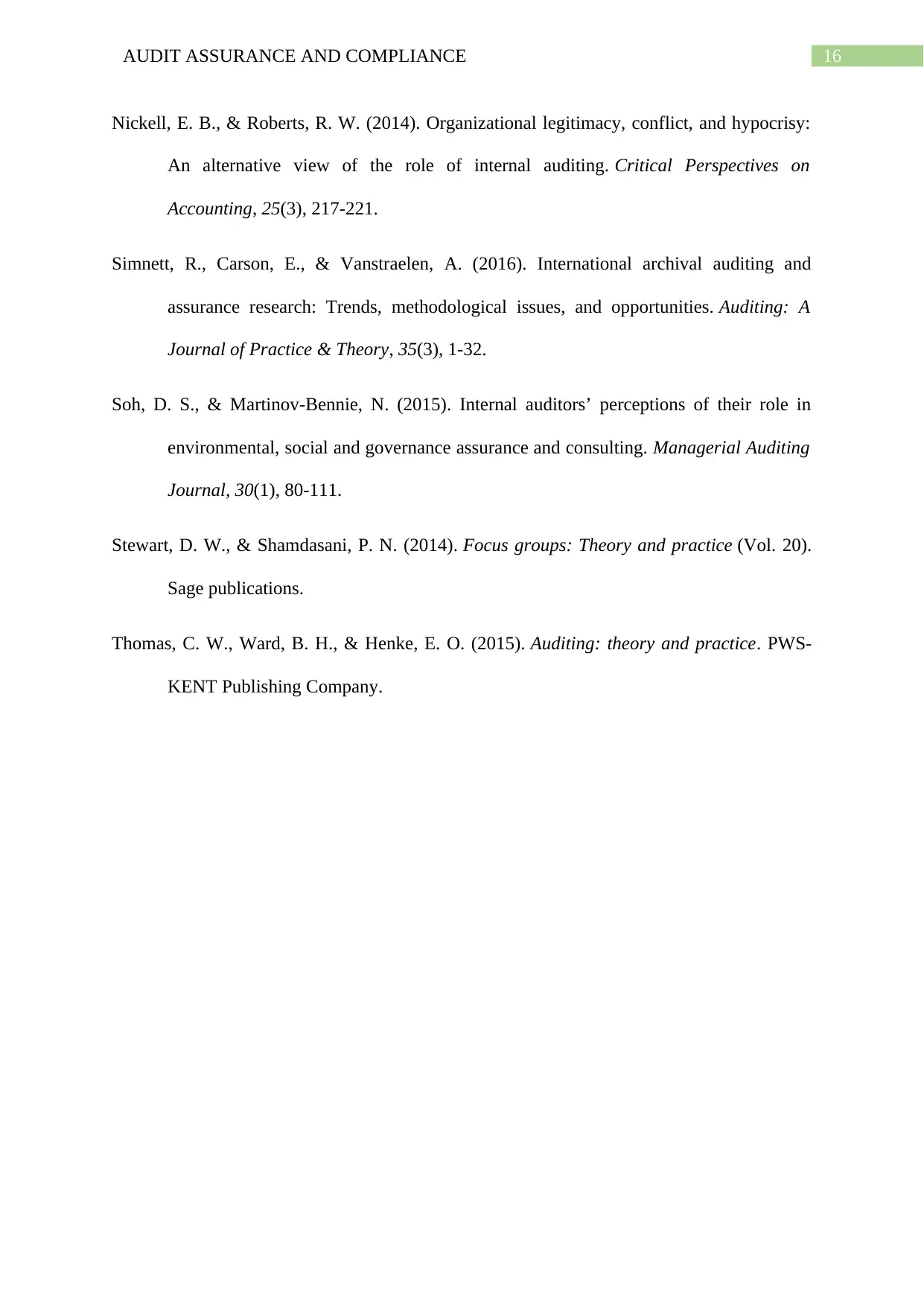
16AUDIT ASSURANCE AND COMPLIANCE
Nickell, E. B., & Roberts, R. W. (2014). Organizational legitimacy, conflict, and hypocrisy:
An alternative view of the role of internal auditing. Critical Perspectives on
Accounting, 25(3), 217-221.
Simnett, R., Carson, E., & Vanstraelen, A. (2016). International archival auditing and
assurance research: Trends, methodological issues, and opportunities. Auditing: A
Journal of Practice & Theory, 35(3), 1-32.
Soh, D. S., & Martinov-Bennie, N. (2015). Internal auditors’ perceptions of their role in
environmental, social and governance assurance and consulting. Managerial Auditing
Journal, 30(1), 80-111.
Stewart, D. W., & Shamdasani, P. N. (2014). Focus groups: Theory and practice (Vol. 20).
Sage publications.
Thomas, C. W., Ward, B. H., & Henke, E. O. (2015). Auditing: theory and practice. PWS-
KENT Publishing Company.
Nickell, E. B., & Roberts, R. W. (2014). Organizational legitimacy, conflict, and hypocrisy:
An alternative view of the role of internal auditing. Critical Perspectives on
Accounting, 25(3), 217-221.
Simnett, R., Carson, E., & Vanstraelen, A. (2016). International archival auditing and
assurance research: Trends, methodological issues, and opportunities. Auditing: A
Journal of Practice & Theory, 35(3), 1-32.
Soh, D. S., & Martinov-Bennie, N. (2015). Internal auditors’ perceptions of their role in
environmental, social and governance assurance and consulting. Managerial Auditing
Journal, 30(1), 80-111.
Stewart, D. W., & Shamdasani, P. N. (2014). Focus groups: Theory and practice (Vol. 20).
Sage publications.
Thomas, C. W., Ward, B. H., & Henke, E. O. (2015). Auditing: theory and practice. PWS-
KENT Publishing Company.
1 out of 17
Related Documents
Your All-in-One AI-Powered Toolkit for Academic Success.
+13062052269
info@desklib.com
Available 24*7 on WhatsApp / Email
![[object Object]](/_next/static/media/star-bottom.7253800d.svg)
Unlock your academic potential
© 2024 | Zucol Services PVT LTD | All rights reserved.





